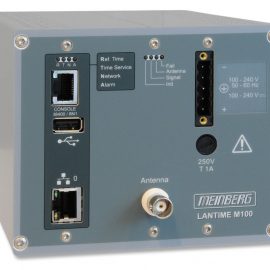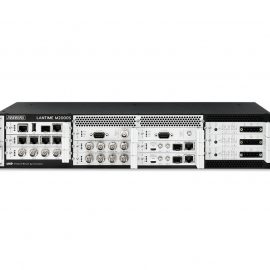Overview
Just like the M3000 standard model, the LANTIME M3000S supports the following slot types:
IMS-CLK: Up to two reference clock modules (redundant mode)
IMS-SCU: Accepts an RSC module for redundant operation (two CLK modules installed) or an SPT module for a single CLK configuration
IMS-PSU:Up to four high efficiency redundant power supplies (AC and DC versions available)
IMS-CPU: Central processor module providing NTP / SNTP time synchronization as well as remote and local management and configuration interfaces
IMS-IO: A variety of output signals for all types of synchronization tasks:
electrical and optical pulses, frequencies, time codes and serial time messages as well as additional network interfaces for network synchronization (IEEE-1588, NTP, Synchronous Ethernet) and additional remote management capabilities
Includes: High-End NTP Network Time Server for your Network:
With several thousand NTP requests per second (depening on the installed CPU module), the system is able to provide time for hundreds and thousands of NTP clients. The LANTIME management CPU module supports the following protocols: NTP / SNTP (v2, v3, v4), HTTP (S), SSH, Telnet, SNMP (v1, v2, v3), FTP, SFTP, DHCP/DHCPv6. For each system, up to 99 logical network interfaces are available (99 IPv4 and 99 IPv6 addresses, each logical interface can be assigned to one VLAN ID). Enterprise-grade features such as IPv6/Dual Stack support, IEEE 802.1Q VLAN support, LACP/high availability bonding as well as DSCP and IEEE802.1p QoS/CoS traffic prioritization ensure that this product can be installed and operated in almost every critical environment: a financial data center; an electrical substation; an NGN telecommunication network; a digital broadcasting infrastructure ; air traffic control systems and many many other environments.
Scalable Synchronization Solution:
All modules are hot-pluggable and can be configured via a central web interface or a CLI. An almost endless number of combinations of input and output modules handles almost any synchronization task and allows the system to fit into many different roles. The field-upgradeable and therefore highly scalable and flexible IMS concept will grow with your demands. New technologies can be easily integrated into your existing devices as soon as a corresponding module is available, supporting a new connector, signal type or protocol. This protects your investments as it removes the requirement to replace existing devices or add complete new systems when your sync requirements change.
Flexible Synchronization References:
IMS-MRI:Standard reference input cards supporting a number of different input signals like 1PPS, 10MHz, IRIG DCLS, IRIG AM IMS-ESI: Extended reference inputs for synchronization sources like E1/T1 framed and unframed signals Both of these slot types can alternatively accept I/O cards and therefore can be used to add output modules or network interfaces, resulting in a maximum of 10 output modules per chassis in combination with the 6 I/O slots. Due to the hot-plug capabilities of the IMS platform it is possible to add additional modules or replace modules with zero downtime and no negative impact on the system and its modules.
Power supply failures and a large number of additional synchronization related alarms can be communicated using several different protocols, for example mail/SMTP messages, SNMP traps, SYSLOG messages, or alarm relay cards.
IMS Modules :
Most standard output signals like pulses (1PPS, 1PPM, programmable pulses) and frequencies (10MHz, 2.048MHz, frequency synthesizer 1kHz-10MHz) are provided by two versatile I/O cards named BPE and CPE. Both of these two modules have been designed to cover a wide range of interface and signal/protocol requirements. They feature a two-tier architecture with a back-end and front-end. While the back-end is responsible for internally routing the backplane IMS synchronization signals (in case of the BPE) or for autonomously generating a wide range of different signals by using a microprocessor (on a CPE), the front-end makes a selection of the signals available on physical connectors. Due to this design, it is very easy to support a large number of different electrical or optical physical interfaces, like BNC, SMA, Twinax, 2-pin DFK, DSUB9 and ST/SC FO connectors.
An impressive number of specialized IMS modules covers other application requirements, for example E1/T1 framed/unframed synchronization signals with full SSM/BOC support or low phase noise 10MHZ sine wave frequency outputs. Additional network interfaces for NTP, PTP/IEEE 1588, SyncE and remote management access are available, too.






Leave a Reply